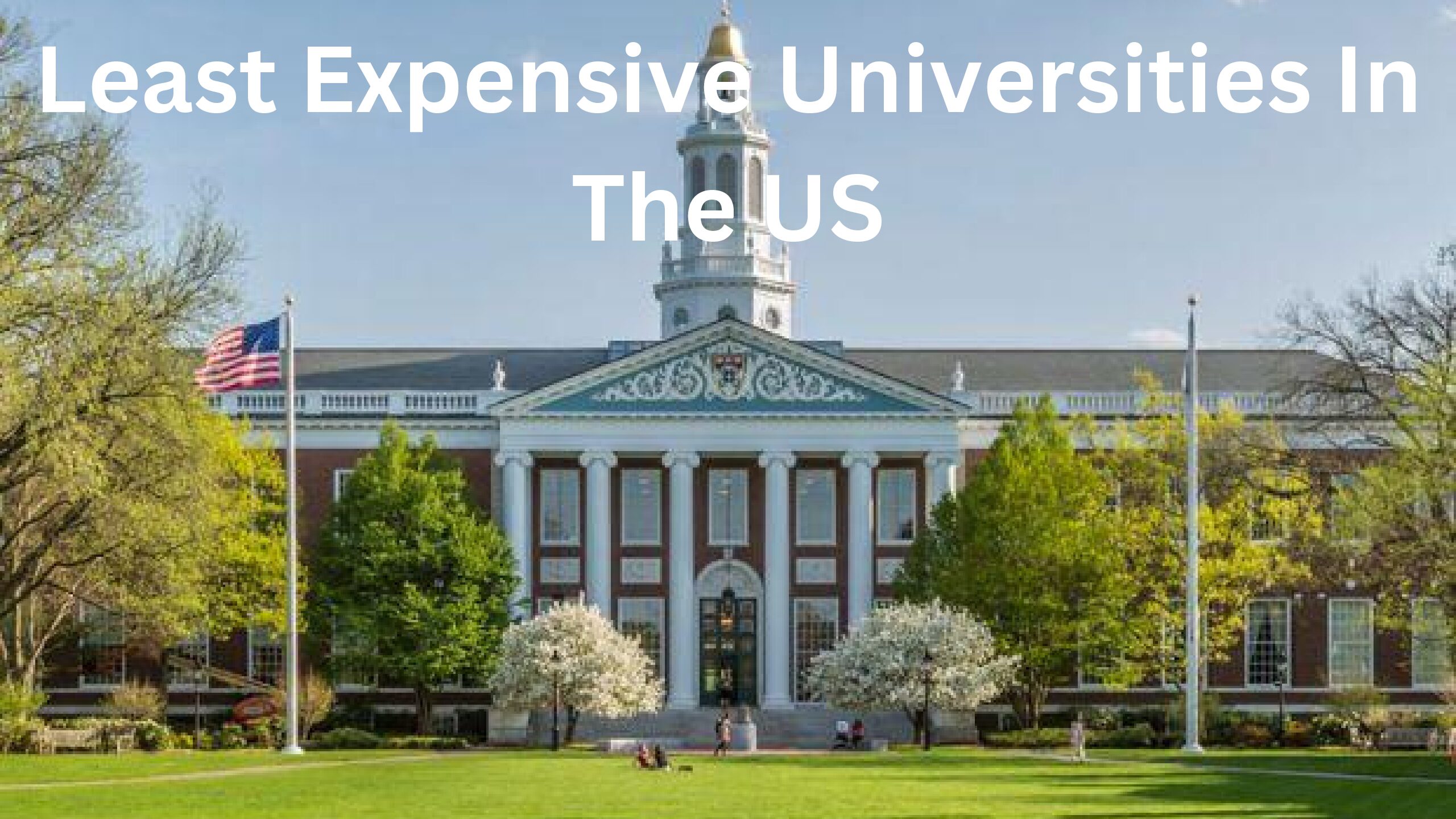Halloween Trends
Least Expensive Universities In The US

Introduction to Affordable Education in the US
A Brief Overview of Rising Tuition Costs
Least expensive universities in the US: In recent years, the cost of higher education in the United States has skyrocketed, leaving many students and families struggling to afford college tuition. This trend has led to a growing concern about the accessibility of education and the need for affordable options.
Importance of Finding Affordable Options
Access to quality education is essential for individual success and societal progress. However, the rising cost of tuition has made it increasingly challenging for students from low-income backgrounds to pursue higher education. Therefore, the importance of finding affordable universities cannot be overstated.
Understanding the Criteria for Least Expensive Universities
Factors Affecting Affordability
Several factors contribute to the affordability of universities, including tuition fees, living expenses, financial aid availability, and location. Understanding these factors is crucial for identifying institutions that offer the best value for students’ money.
Metrics for Ranking
To determine the least expensive universities in the US, various metrics are used, such as average tuition and fees, cost of living, and financial aid packages. By analyzing these metrics, prospective students can make informed decisions about which institutions align with their budgetary constraints.
Public Universities Offering Affordable Education
Advantages of Public Institutions
Public universities often provide a more affordable option for students compared to private institutions. With funding from state governments, public universities can offer lower tuition rates and generous financial aid packages, making higher education accessible to a broader range of students.
Top Affordable Public Universities
In the United States, there are numerous public universities renowned for their affordability and quality education. From flagship state universities to regional colleges, these institutions provide diverse academic programs at a fraction of the cost of private universities.
Private Universities with Affordable Tuition
Benefits of Private Institutions
While private universities are often perceived as expensive, many institutions are committed to making education accessible by offering substantial financial aid packages and scholarships. Additionally, private universities may provide unique academic opportunities and smaller class sizes, enhancing the overall learning experience for students.
Notable Private Universities with Reasonable Costs
Contrary to popular belief, there are private universities in the US that prioritize affordability without compromising on quality. These institutions leverage endowments, grants, and fundraising efforts to reduce tuition costs and ensure that students from diverse socioeconomic backgrounds can access a high-quality education.
Community Colleges: A Cost-Effective Alternative
Exploring the Value of Community Colleges
Community colleges play a crucial role in expanding access to higher education by offering affordable tuition rates and flexible class schedules. These institutions serve as an entry point for many students, providing academic and vocational programs that prepare individuals for the workforce or transfer to four-year universities.
Top Community Colleges for Affordability
Across the United States, community colleges are known for their affordability and quality education. From technical training programs to associate degree pathways, these institutions cater to diverse student needs and provide a supportive learning environment conducive to academic success.
Regional Universities: Balancing Cost and Quality
Definition and Role of Regional Universities
Regional universities play a vital role in higher education by serving specific geographic areas and offering a diverse range of academic programs tailored to local workforce needs. These institutions are often characterized by their focus on undergraduate education, smaller class sizes, and close-knit campus communities. Regional universities bridge the gap between community colleges and research-intensive institutions, providing affordable options for students seeking quality education within their region.
Cost-Effective Regional Institutions
Unlike flagship state universities or elite private colleges, regional universities typically have lower tuition rates and fees, making them a cost-effective choice for students on a budget. Additionally, many regional universities offer generous scholarships, grants, and tuition discount programs to attract and retain talented students. By prioritizing affordability and accessibility, these institutions empower students to pursue their academic goals without accumulating substantial debt.
Online Universities: The Future of Affordable Education
Rise of Online Learning
The advent of online education has revolutionized the way students access and engage with academic content, providing a flexible and cost-effective alternative to traditional brick-and-mortar institutions. Online universities leverage technology to deliver coursework remotely, allowing students to study from anywhere with an internet connection. This flexibility eliminates the need for commuting or relocating, reducing overall educational costs and making higher education more accessible to non-traditional learners.
Affordable Online University Options
Numerous online universities offer accredited degree programs at a fraction of the cost of traditional universities. These institutions often have lower overhead expenses, allowing them to pass on the savings to students in the form of reduced tuition rates and fees. Additionally, online universities may offer competency-based learning models, allowing students to progress at their own pace and potentially accelerate their time to degree completion. By choosing an affordable online university, students can achieve their educational goals without sacrificing quality or convenience.
Scholarships and Financial Aid Opportunities
Importance of Scholarships and Grants
Scholarships and grants play a crucial role in making higher education more affordable for students from all backgrounds. Unlike loans, which must be repaid with interest, scholarships and grants provide free money that does not require repayment, reducing the financial burden on students and their families. These financial aid opportunities come from various sources, including federal and state governments, private organizations, and individual universities.
Finding and Applying for Financial Aid
Navigating the scholarship and financial aid application process can be overwhelming for many students. However, with careful research and planning, students can uncover a multitude of opportunities to fund their education. From merit-based scholarships to need-based grants, there are numerous avenues for securing financial assistance. By utilizing online scholarship databases, seeking guidance from high school counselors, and reaching out to university financial aid offices, students can maximize their chances of receiving financial aid awards.
Work-Study Programs: Earning While Learning
Understanding Work-Study Programs
Work-study programs present students with a unique opportunity to gain practical work experience while simultaneously earning income to support their education. Typically funded by the federal government and managed by educational institutions, these programs offer part-time positions both on and off-campus. Students engage in a variety of roles, ranging from field-specific tasks to general administrative duties.
Benefits of Work-Study Integration
Participating in work-study programs not only provides financial assistance but also fosters academic and professional growth. Students can apply theoretical knowledge from their studies to real-world scenarios, honing valuable skills such as time management and teamwork. Moreover, the income generated through work-study positions can alleviate the financial strain of tuition fees and other educational expenses, easing the burden on students and their families.
Hidden Costs of Education
Exploring Additional Financial Burdens
Beyond tuition fees, students must consider a range of hidden costs associated with pursuing higher education. These expenses encompass textbooks, accommodation, transportation, meals, and personal necessities. Neglecting to factor in these costs can lead to unexpected financial challenges and strain on students’ finances.
Mitigating Hidden Costs
To mitigate the impact of hidden expenses, students can adopt proactive financial management strategies. Utilizing resources such as second-hand bookstores, opting for off-campus housing, and preparing meals at home can significantly reduce expenditures. Additionally, students can tap into campus amenities like food assistance programs and financial literacy workshops to stretch their budgets and navigate financial hurdles more effectively.
Balancing Affordability with Quality Education
Striking a Harmonious Balance
While affordability is a critical factor in choosing a university, it is imperative to uphold standards of academic excellence. Achieving a harmonious balance between cost considerations and educational quality ensures that students receive a rewarding and enriching college experience. Factors such as robust academic offerings, faculty expertise, and comprehensive student support services should be carefully weighed alongside financial considerations.
Making Informed Choices
Informed decision-making lies at the heart of selecting the right educational institution. Prospective students should conduct thorough research, evaluating factors such as program accreditation and graduation rates. Campus visits, interactions with current students and faculty, and participation in informational sessions offer valuable insights into the university’s culture and ethos..
FAQs
1. What defines a university as “affordable”?
A university is considered affordable based on its tuition fees, living expenses, and the availability of financial aid. Affordable universities typically offer lower tuition rates compared to other institutions and provide various scholarship and grant opportunities to assist students in covering expenses.
2. Are there any prestigious universities known for their affordability?
Yes, there are several prestigious universities in the US known for offering generous financial aid packages and scholarships to make education more affordable for students. Institutions like Harvard University, Princeton University, and Stanford University have robust financial aid programs that ensure access to education regardless of financial background.
3. How can international students find affordable options in the US?
International students can explore various avenues to find affordable education options in the US. They can research universities that offer scholarships specifically for international students, consider community colleges or state universities with lower tuition rates, and explore online degree programs that may offer more affordable tuition fees.
4. What resources are available for students struggling with tuition costs?
Students struggling with tuition costs can seek financial assistance through scholarships, grants, work-study programs, and student loans. Additionally, universities often have financial aid offices that can provide guidance and support in navigating the financial aid process and exploring available resources.
5. How do I know if a university’s financial aid package is sufficient for my needs?
To determine if a university’s financial aid package is sufficient, students should carefully review the details of the package, including grants, scholarships, and loans offered. They should also consider factors such as the cost of attendance, living expenses, and potential income from part-time work. Comparing financial aid packages from multiple universities can help students make informed decisions about which institution offers the best financial support for their needs.
Conclusion
In conclusion, affordable options abound in the US for students seeking higher education. Through scholarships, financial aid, and smart choices, students can overcome financial hurdles. It’s essential to balance affordability with quality, ensuring students receive the support needed to succeed. By fostering a collaborative environment focused on accessibility and equity, we pave the way for a brighter future.
Halloween Trends
Powering Dreams: Exploring Columbia University in New York

Welcome to the captivating realm of Columbia University in New York, a beacon of intellectual brilliance nestled in the bustling heart of the Big Apple. From its founding in 1754 to its current standing as a global leader in higher education, Columbia University has consistently epitomized academic excellence and innovation.
Unveiling the Legacy: Columbia University in New York
Embark on a journey through time as we delve into the storied past and illustrious present of Columbia University in New York.
The Birth of a Titan: Founding and History
Dive into the origins of Columbia University, tracing its inception back to the colonial era and exploring pivotal moments that shaped its trajectory.
Architectural Marvels: Campus Highlights
Immerse yourself in the architectural splendor of Columbia University’s campus, from the iconic Low Library to the tranquil haven of Morningside Heights.
Academic Eminence: Programs and Departments
Explore the diverse array of academic programs and departments that distinguish Columbia University as a hub of intellectual exploration and scholarly achievement.
Global Impact: Research and Innovation
Uncover the groundbreaking research initiatives and innovative projects that cement Columbia University’s status as a global powerhouse of knowledge creation.
Cultural Melting Pot: Diversity and Inclusion
Celebrate the vibrant tapestry of cultures and perspectives that thrive within the diverse community of Columbia University, fostering a spirit of inclusivity and collaboration.
Student Life Extravaganza: Clubs and Activities
Embark on a whirlwind tour of student life at Columbia University, where a myriad of clubs, organizations, and extracurricular activities await to enrich the collegiate experience.
Inspirational Figures: Notable Alumni
Pay homage to the luminaries and trailblazers who once walked the hallowed halls of Columbia University, leaving an indelible mark on the world stage.
Beyond the Classroom: Internship and Career Opportunities
Unlock a treasure trove of internship and career opportunities available to Columbia University students, paving the way for future success in diverse fields and industries.
Embracing Innovation: Technology and Entrepreneurship
Discover the dynamic nexus of technology and entrepreneurship at Columbia University, where aspiring innovators and visionaries turn their bold ideas into reality.
Sustainability Crusade: Environmental Initiatives
Delve into Columbia University’s commitment to sustainability and environmental stewardship, spearheading initiatives to create a greener, more sustainable future.
Community Engagement: Outreach and Service
Witness the transformative impact of Columbia University’s community engagement efforts, as students, faculty, and staff come together to serve and uplift those in need.
Future Horizons: Vision and Growth
Peer into the future as Columbia University continues to evolve and expand its horizons, blazing trails of innovation and excellence in the ever-changing landscape of higher education.
Frequently Asked Questions (FAQs)
- What majors are offered at Columbia University in New York? Columbia University offers a diverse range of majors spanning arts, humanities, sciences, engineering, and more, catering to a wide array of academic interests and aspirations.
- Is Columbia University in New York a part of the Ivy League? Yes, Columbia University is a proud member of the esteemed Ivy League, renowned for its academic prestige and rigorous standards of excellence.
- How competitive is admissions at Columbia University? Admissions to Columbia University are highly competitive, with acceptance rates typically hovering around the single digits. However, the university values holistic evaluation of applicants, considering factors beyond just academic achievements.
- What is the campus atmosphere like at Columbia University? Columbia University boasts a vibrant and dynamic campus atmosphere, characterized by intellectual curiosity, cultural diversity, and a spirit of innovation.
- Are there opportunities for undergraduate research at Columbia University? Yes, Columbia University offers abundant opportunities for undergraduate research across various disciplines, allowing students to engage in hands-on learning and contribute to cutting-edge discoveries.
- How can prospective students schedule a campus visit to Columbia University? Prospective students can schedule a campus visit to Columbia University through the university’s admissions office website, where they can explore campus tours, information sessions, and other visitation options.
Conclusion
In conclusion, Columbia University in New York stands as a beacon of academic excellence, innovation, and inclusivity, shaping the minds of future leaders and pushing the boundaries of knowledge. From its rich history to its vibrant campus life, Columbia University offers a transformative educational experience like no other.
-

 Thanksgiving Trends9 months ago
Thanksgiving Trends9 months agoHappy Thanksgiving: Tips for a Joyful and Stress-Free Celebration
-

 Thanksgiving Trends8 months ago
Thanksgiving Trends8 months agoUnique & Attractive Snoopy Thanksgiving Decorations 2023 – 2024
-

 Christmas Trends8 months ago
Christmas Trends8 months ago10 Unforgettable Christmas Gift Ideas That Will Make Their Spirits Soar!
-

 Christmas Trends8 months ago
Christmas Trends8 months agoBest & Unique Minimalist Christmas Decor Ideas 2023 – 2024
-

 Thanksgiving Decor8 months ago
Thanksgiving Decor8 months agoUnique Paper Thanksgiving Decorations for a Green Celebration 2023 – 2024
-

 Christmas Trends8 months ago
Christmas Trends8 months ago70+ Best & Cheap Outdoor Christmas Decorations for 2024 – 2025
-

 Thanksgiving Trends9 months ago
Thanksgiving Trends9 months agoThanksgiving Fun Traditional Activities Ideas in 2023 – 2024
-

 Thanksgiving Trends9 months ago
Thanksgiving Trends9 months agoBest Thanksgiving Vacation Ideas for Families in 2023 – 2024



